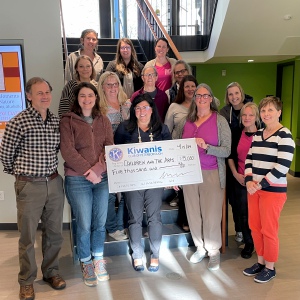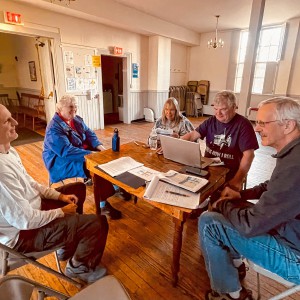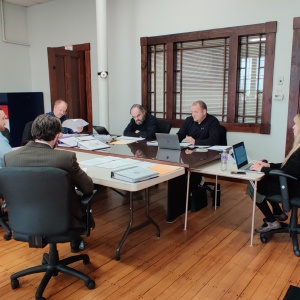Hidden Hancock antenna helping astronomers explore universe
| Published: 06-13-2017 11:23 AM |
Tucked along a remote section of Windy Row in Hancock, a 260-ton, 82-foot diameter antenna looms behind a patch of trees just out of sight from the public road.
A dirt road leads to the unit’s base, and the massive, white orb becomes visible soon after traveling down the path. At its base, the antenna hums, and occasionally moves its disk.
A technician in a control building, which is located adjacent to the antenna, opens a pair of barred double doors in the building on Tuesday afternoon. He says he works there full time operating and maintaining the complex array of equipment, but doesn’t elaborate much further about his day-to-day duties. He says there used to be tours open to the public, but that those don’t happen very often anymore. The technician directs any further questions to a person stationed at the array’s control center in New Mexico, and with that, closes the door and slips back into the dark room.
Meade Cadot, who was a Hancock planning board member when the antenna was built, said he vaguely recalls when the unit came in front of the board in 1986. He said it was a little difficult to come up with appropriate zoning for the antenna, but otherwise, no residents complained and the project continued without a hitch.
And since its establishment in 1993, the unit has been there, and gone largely unnoticed.
“No one says anything about it. I don’t think anyone even notices it anymore,” said Linda Coughlan, the town’s administrative assistant.
The antenna in Hancock is on land between Peterborough and Hancock near hiking trails close to Nature’s Classroom at the Sargent Center Environmental Education, which is owned by Boston University. The parties recently signed on to another 10-year lease for use of the land.
A sign indicates the antenna in Hancock is government property.
Article continues after...
Yesterday's Most Read Articles
 Crash on Route 202 in Jaffrey leads to trapped driver, fuel spill
Crash on Route 202 in Jaffrey leads to trapped driver, fuel spill
 Bernie Watson of Bernie & Louise dies at 80
Bernie Watson of Bernie & Louise dies at 80
 BUSINESS QUARTERLY – New housing projects could provide relief
BUSINESS QUARTERLY – New housing projects could provide relief
 Scott Bakula starring in Peterborough Players’ ‘Man of La Mancha’
Scott Bakula starring in Peterborough Players’ ‘Man of La Mancha’
 Children and the Arts Festival in Peterborough will have bird theme
Children and the Arts Festival in Peterborough will have bird theme
Seth Chatfield, of Peterborough, said he remembers when the antenna went up years ago.
“Sometime after the ‘Government Property’ sign went up, I thought that it was part of the SETI (Search for Extraterrestrial Intelligence) array. Seemed to make sense at the time,” said Chatfield.
Tim Selby, who lives in Peterborough, said he also thought it belonged to SETI, or perhaps, was privately owned before he was given an opportunity to tour the place with his young son a few years ago.
Although it doesn’t receive much attention in the area, the antenna is one of 10 radio telescopes in the Very Long Baseline Array, or VBLA, that spans more than 5,000 miles from Hawaii to the Virgin Islands.
The synchronized array functions as a single radio telescope system nearly the size of the Earth.
The project is overseen by the federally funded National Radio Astronomy Observatory, and is the largest dedicated, full-time astronomical unit in the world.
In 2011, researchers used the VLBA to find a galaxy 450 million light years from Earth called NGC 6264.
“Objects studied with the VLBA include stars, both young and old; giant clouds of gas and dust where new stars are being born; galaxies and the powerful phenomena associated with supermassive black holes at their cores; supernova explosions; and many more,” said Dave Finley, a public information officer with the NRAO who is based at the array’s headquarters in Socorro, New Mexico.
The array’s sharp radio “vision” (the array has a resolution 400 times better than the Hubble telescope, according to the National Aeronautics and Space Administration) has allowed scientists to make the most precise astronomical distance measurements ever, which have improved the map of our galaxy, the Milky Way.
Finley said the same precision also allows it to serve as a valuable tool for measuring tectonic plates on the Earth that have helped scientists better understand earthquakes and volcanoes.
The telescope points to an object in the universe that is emitting radio waves and because of the way the dish is shaped, those waves bounce off of a subreflector, and then back down.
In a circle around the center of the dish there are several feedhorns, each which carry the waves into a receiver. Each receiver pair covers a different range of radio frequencies.
Finley said the information is stored on high-density packs of disk drives, which are shipped to Socorro, New Mexico, and simultaneously read on a special purpose computing facility that produces raw material that astronomers can use to make high-resolution images.
On the NRAO website, colorful images of supermassive black holes, the death and birth of stars, and galaxies are on display.
“We have scientists from all over the world who are using this data,” Finley said.
Finley said astronomers have discovered thousands of planets orbiting other stars, some of which are in what is referred to as the “habitable zone” where their surface temperatures should be favorable for liquid water. Finley said in giant clouds of gas and dust from which new stars and planets are formed, astronomers have discovered numerous complex molecules, including sugars and alcohols that are precursors to life.
“Based on all this evidence, it seems that the likelihood of extraterrestrial life is very good,” Finley said. “We’re still awaiting evidence to prove it.”

 Rindge Recreation Department organizes a trip to Converse Meadow
Rindge Recreation Department organizes a trip to Converse Meadow Greenfield Community Power Committee approves identifying possible suppliers
Greenfield Community Power Committee approves identifying possible suppliers Wilton Select Board discusses options for ARPA funds
Wilton Select Board discusses options for ARPA funds The Rev. Barbara Thorngren of Temple works to build connections
The Rev. Barbara Thorngren of Temple works to build connections
